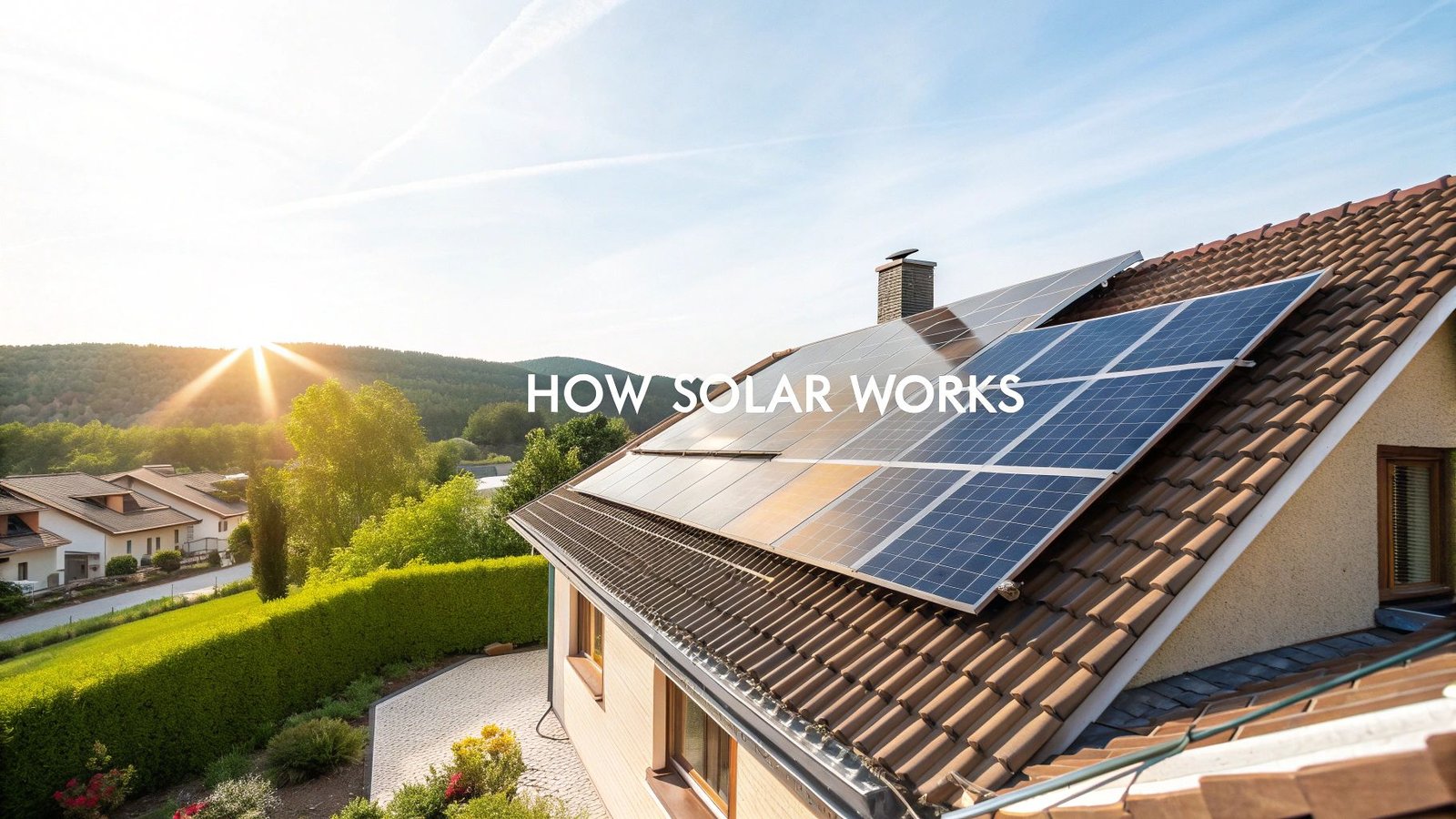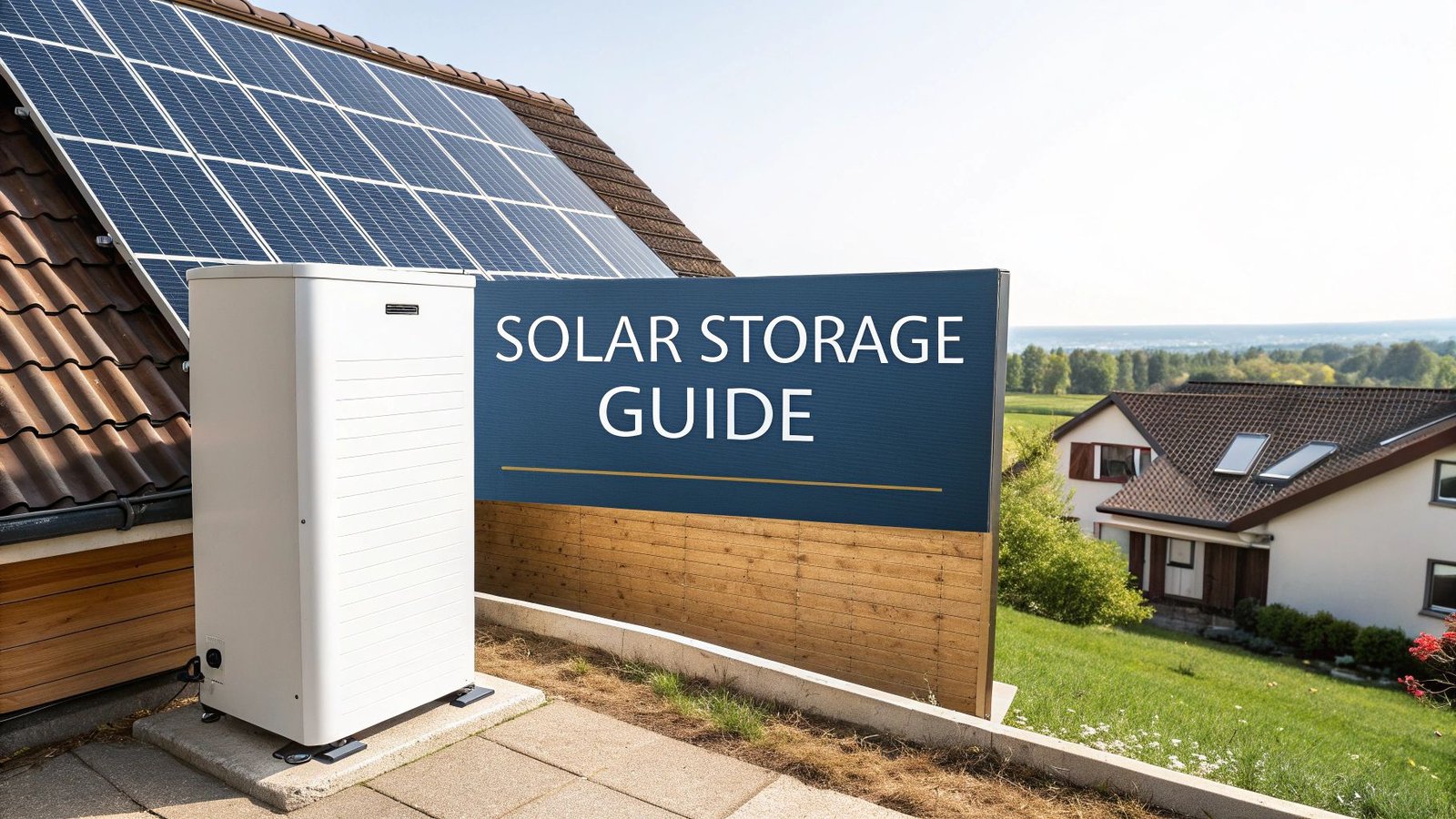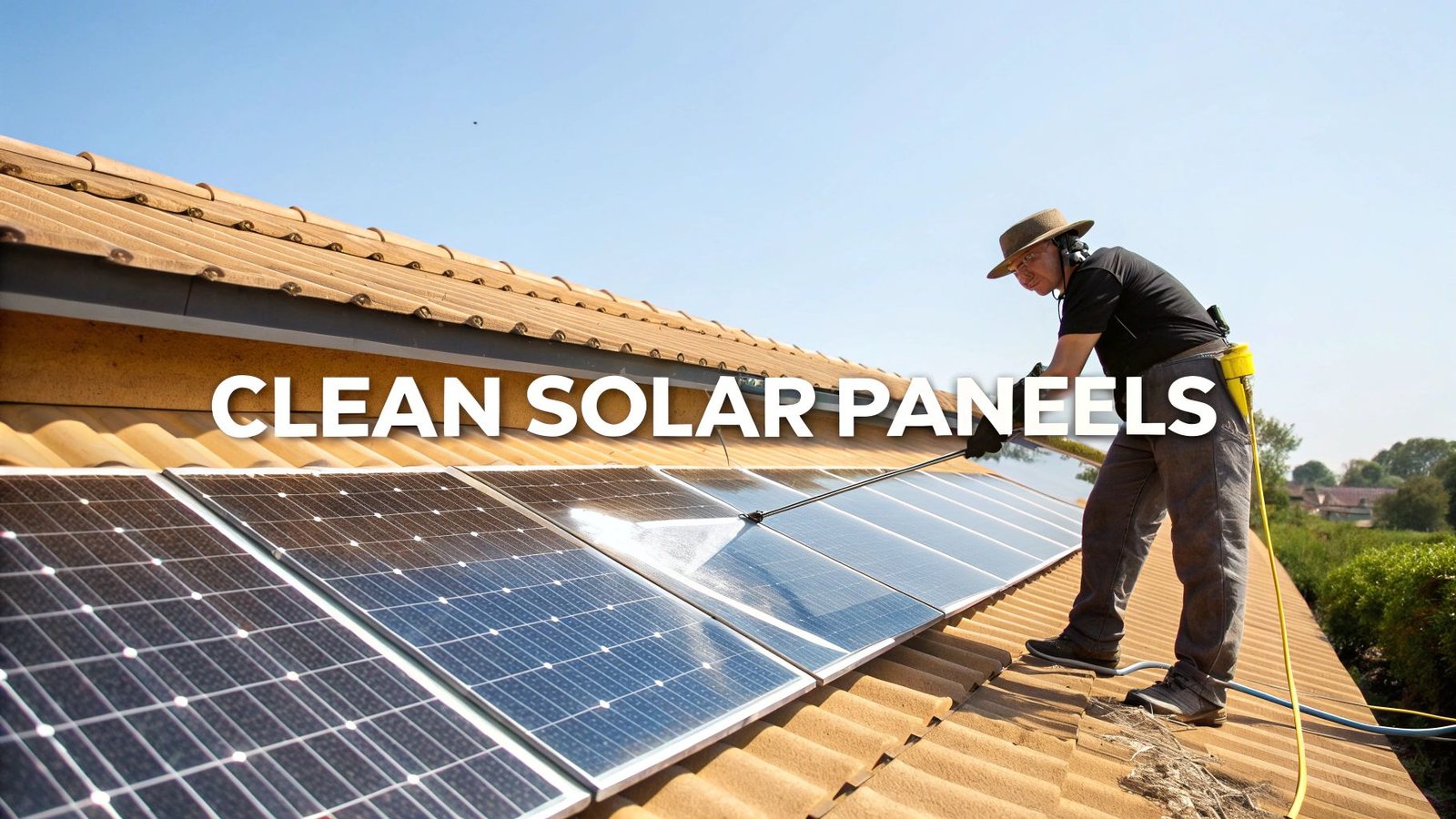At its core, a solar panel works by turning sunlight into electricity you can actually use, all thanks to something called the photovoltaic effect. It’s a clean, quiet process that happens in three main stages.
First, the solar cells in the panel soak up sunlight. This creates a flow of direct current (DC) electricity. Then, a crucial piece of equipment called an inverter steps in to change that DC power into the alternating current (AC) electricity that runs your home.
From Sunlight to Electricity in Three Simple Steps
Ever look up at a solar panel on a roof and wonder how that silent, still object can power a blender or charge a laptop? The principle behind it is surprisingly elegant.
Think of it like a plant performing photosynthesis. A plant captures sunlight and turns it into chemical energy to grow. A solar panel does something similar, only it converts that sunlight into electrical energy.
This entire transformation from a sunbeam to a usable watt of power unfolds in a simple, three-step dance. Each step has its own part to play, working together to bring power from the sky right to your wall outlets. Let's break down how that journey happens.
The Three Core Stages of Solar Power
The whole system is designed to shepherd energy from the moment it's captured to the moment you flip a switch. Here’s a look at what each part of the system does.
-
Step 1: Absorption: It all begins with the sun. Tiny particles of light, called photons, travel 93 million miles and hit the photovoltaic cells in your solar panels. This impact is the spark that kicks off the whole process.
-
Step 2: Conversion: When these photons strike the solar cells, they knock electrons loose, forcing them to start moving. This flow of electrons is, by definition, an electrical current. But at this stage, it's direct current (DC), which isn't the kind of power your home appliances use.
-
Step 3: Inversion: The DC electricity then flows from the panels down to a device called an inversor. This is the brains of the operation. It takes the raw DC power and converts it into alternating current (AC) electricity—the standard, stable power that runs everything in your house.
To wrap it all up, here’s a quick table that lays out the journey from sunlight to usable power.
Key Stages of Solar Energy Conversion
This simple breakdown shows how the system turns complex physics into a straightforward sequence of events, demystifying how your home gets powered by the sun.
| Stage | Componente | Function |
|---|---|---|
| 1. Absorption | Solar Panel (Photovoltaic Cells) | Captures photons from sunlight to get the energy conversion process started. |
| 2. Conversion | Solar Panel (Photovoltaic Cells) | Creates a flow of electrons, generating direct current (DC) electricity. |
| 3. Inversion | Inverter | Converts the raw DC electricity into usable alternating current (AC) power for your home. |
From the panel to the inverter to your outlets, each component has a clear job to do. It’s a seamless and reliable way to generate clean energy right where you need it most.
The Science Inside Photovoltaic Cells
To really get how solar panels work, we need to zoom in. Forget the rooftop for a second and think at the microscopic level. The real magic happens inside the individual photovoltaic cells, where sunlight is turned into electricity. This is called the photovoltaic effect.
It all starts with silicon, the semiconductor material that’s the heart and soul of most solar cells. On its own, silicon is pretty neutral. To turn it into a miniature power plant, manufacturers deliberately add impurities, a process known as doping.
Creating an Electric Field
Here's how that works. One layer of silicon gets a dose of phosphorus, which brings extra electrons to the party. This creates a negative charge, giving us the n-type layer. The other layer is doped with boron, which has fewer electrons, creating a positive charge and what we call the p-type layer.
When you sandwich these two layers together, something cool happens. The surplus electrons from the n-type side naturally drift over to fill the "empty spots" on the p-type side. This migration of electrons creates a powerful electric field right at the boundary where they meet, known as the p-n junction. This built-in electric field is the secret sauce—it's the engine that will drive the flow of electricity.
The infographic below gives you a bird's-eye view of energy's journey from the sun, through the panel, and into your home.

While that graphic shows the big picture, the real action starts with the photovoltaic effect happening inside every single cell.
Putting Sunlight to Work
Think of the electric field we just created as a one-way slide. Now, imagine sunlight, which is made of tiny energy packets called photons, hitting the silicon cell. When a photon strikes the cell, it transfers its energy and knocks an electron loose, basically placing it at the top of that slide.
Once that electron is free, the electric field takes over. It acts like gravity, pushing the electron down the slide in a single, controlled direction. This directs it towards conductive metal plates on the cell's surface. When you get billions of these electrons moving in an organized flow, you've got yourself an electrical current.
Lo más importante: A solar cell doesn't invent new electrons. It just uses the sun's energy to get existing electrons moving, and the internal electric field is what corrals them into a useful current.
The electricity generated at this stage is direct current (DC). This core science has actually been around for a long time; the photovoltaic effect was first observed by physicist Alexandre-Edmond Becquerel way back in 1839. Bell Labs built the first working silicon solar cell in 1954 with just 6% efficiency. By 1985, researchers had already pushed that number past 20%, and the technology has only gotten better since. If you're curious, you can explore a detailed history of these solar innovations to see just how far we've come.
Anatomy of a Modern Solar Panel
That magic happening inside a solar cell is just one part of the story. The solar panel itself is a tough, multi-layered sandwich, engineered to keep those delicate cells safe and productive for decades out in the elements. Every single layer has a job to do, all working together to turn sunshine into power.

If you were to peel one apart, you’d find it’s far more than just a sheet of silicon. Each piece is chosen to help the panel survive everything from hailstorms to blistering heat for 25 años o más. Let's break down what's inside.
The Protective Outer Layers
The outer shell of a solar panel has to be both tough as nails and crystal clear. It's a constant balancing act between protecting the sensitive electronics inside and letting as much sunlight as possible pass through.
The very top layer is usually cristal templado, which is incredibly durable and can take a serious impact. Right under that, you'll find an anti-reflective coating (ARC). This isn't just window dressing; this film is designed to cut down on glare, ensuring more light gets absorbed by the cells instead of bouncing off. It's a small detail that gives a real boost to energy production, especially when the sun is low in the sky.
The Power-Generating Core
Now we get to the heart of the matter—the photovoltaic cells. This is the engine room where sunlight becomes electricity.
The core is made up of a few key things:
- Photovoltaic Cells: These are the silicon wafers we talked about earlier, where all the action happens. A single cell doesn't produce much power on its own, so dozens are wired together in a series to create a useful amount of voltage.
- Encapsulant: The cells are sealed in a clear, weatherproof polymer, most often ethylene vinyl acetate (EVA). This material acts like a cushion, protecting the fragile cells from vibrations while locking out moisture that could cause rust and failure.
A solar panel isn’t a single object but an assembly of individual parts, each chosen for durability and efficiency. The final product is a robust piece of technology built to generate clean energy for decades, even in challenging environments.
Underneath the cells is the hoja posterior, a tough polymer layer that serves as the final line of defense. It's a moisture barrier and an electrical insulator, shielding the panel's guts from humidity and UV exposure from below. If you want to dive deeper, you can explore all the different componentes de un panel solar that make up its structure.
Everything is held together by a rigid marco de aluminio. This gives the panel its strength, keeps it from flexing in the wind, and protects the glass edges from getting chipped during transport and installation. It’s this smart combination of layers that explains how solar panels work so reliably, year after year.
How Your Solar System Powers Your Home
So, your panels have soaked up the sun and created direct current (DC) electricity. That's a great first step, but here's the catch: your home doesn't run on DC power. Everything from your refrigerator to your phone charger needs alternating current (AC) to work.
This is where the real magic happens, thanks to a device called a solar inverter.
Think of the inverter as a translator or a currency converter for electricity. It takes the raw, one-way DC power from your panels and expertly changes it into the smooth, two-way AC power that your home's appliances understand and use. Without this crucial conversion, all that clean energy on your roof would be completely useless.
The Role of the Inverter
The inverter is truly the brain of your entire solar operation.
Once it converts the electricity from DC to AC, it sends that usable power straight to your home's main electrical panel—the breaker box. From there, it flows through your home's wiring to every single outlet and light switch, just like the power you’ve always used from the utility company.
Best of all, this all happens seamlessly. You won't notice a flicker or a change. Your lights turn on, your TV plays, and your coffee brews just like it always has. The only difference is that now, the power is coming directly from the sun.
But not all inverters are created equal. The technology has grown over the years, giving homeowners a few different options. To get a better handle on these devices, you can explore this guide on qué son los inversores solares and how they work.
Comparing Different Inverter Technologies
Choosing the right inverter is one of the most important decisions you'll make. Each type comes with its own set of pros and cons, making them better suited for different homes and situations.
| Inverter Type | How It Works | Lo mejor para |
|---|---|---|
| Inversor de cadenas | A single, central inverter is connected to a "string" of solar panels, converting power from the whole group at once. | Cost-effective setups with simple, unshaded roofs where all panels face the same direction. |
| Microinversores | A small inverter is installed on the back of every single panel, converting DC to AC right at the source. | Homes with tricky roof layouts, occasional shade, or for homeowners who want to track each panel's individual performance. |
| Power Optimizers | A hybrid solution. Optimizers are attached to each panel to condition the DC power before it's sent to a central string inverter for conversion. | A great middle-ground that offers panel-level optimization for shaded roofs, often at a lower cost than a full microinverter system. |
Connecting to the Grid and Net Metering
Your solar system doesn't work in isolation—it stays connected to the local utility grid. This is a good thing! It means you have a reliable backup for those times when your panels aren't producing, like at night or on stormy days.
This connection also opens the door to a major financial perk called net metering. It's a simple but brilliant concept:
- You Make Extra Power: On a bright, sunny afternoon, your panels will probably generate more electricity than your home needs at that moment.
- You Send it to the Grid: Instead of going to waste, this surplus AC power flows back out through your meter and onto the grid for your neighbors to use.
- You Get Paid for It: Your utility company keeps track of this exported power and gives you credits on your bill. In essence, you're spinning your meter backward!
These credits are then applied to your bill, canceling out the cost of any electricity you might need to pull from the grid later on. It’s a fantastic way to make sure every last watt you generate saves you money.
For those looking to take a step further toward energy independence, especially during power outages, pairing your panels with a battery is the way to go. Digging into the different energy storage systems for homes will help you figure out how to get the most out of your solar investment.
Factors That Influence Solar Panel Performance
Now that you know how a solar system gets power to your home, a pretty common question pops up: why does the output change so much from one day to the next? A panel’s energy production isn’t a fixed number; it’s constantly in flux, reacting to what’s happening in the real world. Think of it like a plant—it needs the right amount of sun, water, and good soil to thrive. Your panels are the same, just with different ingredients.
Several key things decide how much electricity your panels can churn out. From the ground your house is built on to the sun's angle in the sky, every little detail matters. Getting a handle on these variables is the key to setting realistic expectations for your solar investment.
Geographic Location and Weather Conditions
The number one factor? Your address. It's no surprise that a home in sunny Arizona is going to generate more solar power than one in overcast Seattle. This all comes down to solar irradiance, which is just a technical term for the amount of sunlight hitting a specific area. More intense, direct sun means more photons smacking into your panels, and that translates directly to more electricity.
graph TD
A[High Solar Irradiance<br>(e.g., Arizona)] --> B[More Photons<br>Hit the Panels];
B --> C[Higher Electricity<br>Production];
D[Low Solar Irradiance<br>(e.g., Seattle)] --> E[Fewer Photons<br>Hit the Panels];
E --> F[Lower Electricity<br>Production];
style A fill:#f9f,stroke:#333,stroke-width:2px
style D fill:#ccf,stroke:#333,stroke-width:2px
Weather, of course, plays a huge role. Bluebird skies are perfect, but panels absolutely still work on cloudy days—they just don't produce as much. A thick layer of clouds can drop production down to just 10-25% of what the panel is rated for. Don't forget about the gunk that builds up over time, either. Dust, pollen, and grime can form a film that blocks sunlight. To keep things humming, it's worth looking into the best solar panel cleaning techniques to maintain peak efficiency.
Panel Angle, Shading, and Temperature
How your panels are physically installed is just as crucial as the weather. The angle (tilt) y orientation (azimuth) are fine-tuned to capture the maximum amount of sun possible as it moves across the sky. For anyone in the Northern Hemisphere, that sweet spot is almost always a south-facing roof.

This graph really shows how much of a difference the right angle makes. As the seasons change, the sun's path shifts, and a well-angled panel can keep soaking up energy effectively. Another performance-killer is shading. Trees, chimneys, and even neighboring buildings can cast shadows that tank your output. Even a tiny shadow on a corner of one panel can drag down the performance of the whole string.
Here’s a twist that surprises a lot of people: heat. Solar panels need sunlight, but they aren't big fans of getting too hot. As a panel’s temperature climbs, its efficiency actually starts to drop. The ideal recipe for peak performance is a cool, crisp, sunny day.
The journey of solar technology from a niche science to a mainstream power source is fascinating. The 1970s oil crisis was a major turning point, pushing governments and companies to pour money into alternative energy. In just one decade, that research push cut the cost of photovoltaic tech by about 80%. To put that in perspective, back in the mid-1950s, a tiny 1-watt solar cell cost around $300. By the late '70s, manufacturing had improved so much that solar was finally becoming a realistic option for more people.
Common Questions About How Solar Panels Work
Once you get the science and the system parts down, the practical, real-world questions usually start popping up. It's one thing to understand the photovoltaic effect, but it's another to know what to expect when the clouds roll in.
Let's clear up some of the most common points of confusion. Think of this as your quick-reference guide for those lingering "what if" questions about going solar.
Do Solar Panels Work on Cloudy Days or at Night?
This is probably the number one question people ask, and it’s a bit of a yes-and-no answer.
Yes, solar panels absolutely work on cloudy days. Their output will be lower, but they don't need intense, direct sunlight to make power. They just need light. Even the diffused light that makes its way through a thick layer of clouds is enough to get those electrons moving and generate electricity. On a really overcast day, you might see production drop to 10-25% of what you'd get in full sun.
pie
title Solar Panel Output on an Overcast Day
"Lost Production" : 80
"Actual Production" : 20
But at night? Nope. When the sun goes down, there's no light to kickstart the energy generation process, so the panels go dormant. If you're wondering what happens after sunset, our guide explains how solar panels work at night when your system is tied to the grid or a home battery.
What Is the Difference Between Panel Types?
When you start shopping for panels, you’ll mostly hear about two kinds: monocrystalline and polycrystalline. The real difference between them comes down to the silicon they’re made from, which impacts how they look, how well they perform, and how much they cost.
| Tipo de panel | Silicon Structure | Apariencia | Key Features |
|---|---|---|---|
| Monocristalino | Made from a single, pure silicon crystal. | Sleek, uniform black color with rounded cell corners. | Higher efficiency, better in low light, and more space-efficient. The trade-off is a higher price tag. |
| Policristalino | Made from multiple silicon fragments melted together. | A speckled, blueish look with perfectly square cells. | Less efficient and a bit larger for the same power output, but they are more affordable to produce. |
Ultimately, choosing between them is a balancing act between your budget, how much roof space you have, and the efficiency you’re aiming for.
How Long Do Solar Panels Last?
Modern solar panels are tough. They're engineered to withstand decades of rain, snow, hail, and sun. Most top-tier manufacturers back their panels with a performance warranty guaranteeing they will still produce at least 80-90% of their original power after 25 años.
xychart-beta
title "Typical Solar Panel Degradation Over 25 Years"
x-axis "Year" [1, 5, 10, 15, 20, 25]
y-axis "Guaranteed Power Output (%)" [80, 100]
line [100, 98, 95.5, 93, 90.5, 88]
bar [98, 96, 93.5, 91, 88.5, 86]
This slow, predictable drop in performance is known as degradation. Even though panels lose a tiny fraction of their output each year, they will keep generating plenty of usable electricity for 30, 40, or even 50 years—long after the official warranty has expired.
It's worth noting that other parts of your system won't last as long. The inverter, which is the brains of the operation, usually needs to be replaced every 10 to 15 years, while the panels on your roof just keep on chugging along.
Ready to see how solar can work for your home? The team at Energía radiante specializes in designing and installing high-quality solar solutions that fit your unique needs. Get your free quote today!




